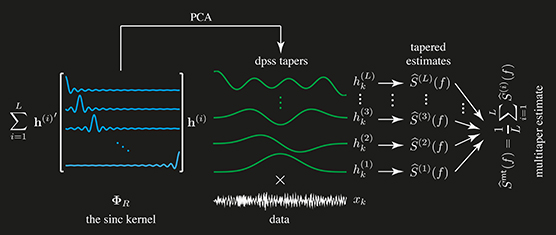Behtash Babadi, Emery N. Brown, University of Maryland, Massachusetts Institute of Technology
Volume 61, Issue 5, Page: 1555-1564

Non-parametric spectral estimation is widely used in applications ranging from radar and seismic data analysis to electroencephalography (EEG) and speech processing. The objective of non-parametric spectral estimation is to use Fourier-based methods to decompose the output of a stochastic system into a frequency domain representation based on a finite data sample. Spectral estimates computed from finite data can be biased or have high error variance. Tapering is a non-parametric method used to reduce bias, whereas lag window smoothing has been used to reduce error variance. Each of these approaches depends on parameters which can be challenging to tune in practice. Perhaps the first non-parametric method to address simultaneously the issues of bias and variance in an ‘optimal’ fashion was the multitaper spectral estimation technique developed by David Thomson in 1982. In recent years, multitaper spectral analysis has gained popularity among some researchers in bioengineering and neuroscience. However, the technique is not as widely used as it could be because, despite being available for more than 30 years, an exposition that makes the power of this approach readily accessible to a general bioengineering audience is not available. We review the conceptual framework of multitaper spectral estimation. We summarize briefly the bias and variance problems by examining two of the basic non-parametric spectral estimation techniques: the periodogram and tapered spectral estimates. We describe how multitaper spectral estimation simultaneously addresses the issues of bias and variance. Finally, we present analyses of EEG recordings during general anesthesia and during sleep to illustrate the application of this technique to real data.

